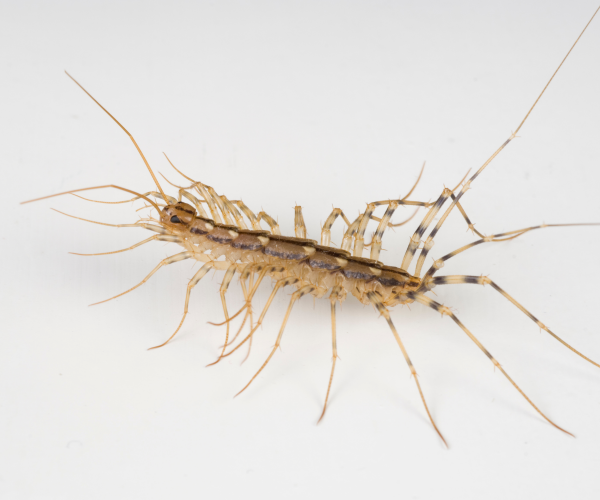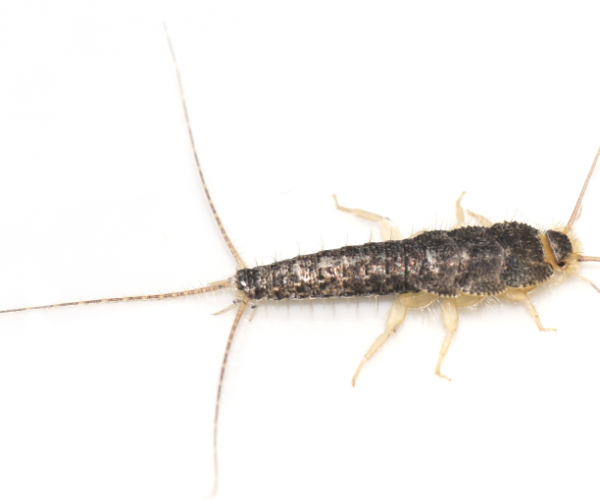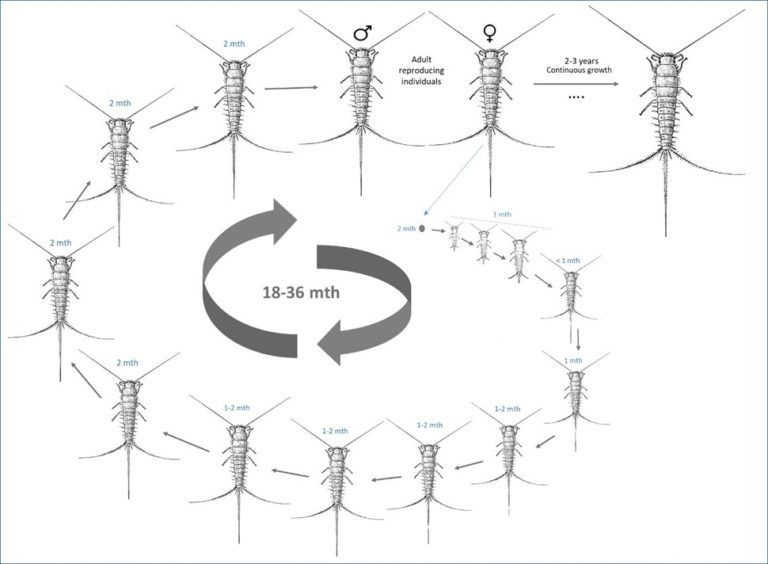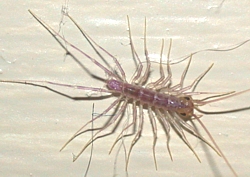Silverfish and house centipedes are two of the most common household pests in the United States.
You’ve probably seen both in your house but don’t know the difference. Are they harmful? Do they bite?
Don’t worry, we’ve got you covered.
In this post, I’ll go over everything you need to know about these small, inconspicuous insects.
Let’s get started.
Silverfish vs House Centipedes: Appearance
It’s not hard to tell the difference between a silverfish and a house centipede once you know what they look like. They each have distinct features and characteristics that make them easy to identify.
What Do House Centipedes Look Like?

The house centipedes name suggests that it has 100 legs; while it might look like it, they only have 30 legs.
They only measure 1 and 1 ½ inches, which means their 30 legs are packed on a small body.
Compared to other centipedes, the house centipedes’ legs are much longer and typically bent at an angle. This typically causes the abdomen of the house centipede to be slightly lifted off the floor.
The color of a house centipede can vary, but they tend to have a yellow, brown, and grey pattern. Their pattern typically includes a yellow abdomen with a brown and grey darker area on top of their abdomen. And several darker stripes on the legs.
- About 1 – 1 ½ inches
- Long and flat
- Segmented body with one pair of legs on each segment
- Adults have around 30 legs
- Yellow, brown, and grey with a pattern on the abdomen and stripes on the leg
What Do Silverfish Look Like?

Silverfish have a unique appearance. They have a long elongated teardrop shape.
They have six legs, two long antennae, and three rear bristles at the end of their body. These bristles look similar to spikes, but they are not.
They are covered in light to dark grey scales that look like armor for battle.
- About ¼ inch to ¾ inch long
- Six legs on the side of their abdomen
- Shiny silver bodies
- Two long antenna
- Three Rear bristles – one at the center and one on each side.
Silverfish vs House Centipedes: Life Cycle
Silverfish Life Cycle

The Silverfish are unique because they don’t reproduce through direct fertilization. Rather than direct fertilization, they do a mating dance. The female will then flea and then they will reunite later.
The males will later stand next to the female and insert sperm into the females’ ovipositors.
Eggs
Silverfish are dangerous because they can produce up to one to three eggs per day. They can also produce eggs all year which allows their populations to grow very fast.
Eggs typically take between 19 to 60 days to hatch. Silverfish pace their eggs in humid conditions but they are versatile insects. They tend to place their eggs in hidden and secluded areas.
Nymphs
Nymphs are around 1mm long and much lighter than adult silverfish. Other than the lighter color nymphs and adults look exactly the same.
Nymphs will molt several times before they become an adult. To go from nymph to adult it typically takes around 60 to 90 days. This takes
Adults
From egg to adult, it typically takes around three to four months. Adults grow to be about ¼ inch to ¾ inch long. One unique characteristic of silverfish is that they continue to molt after they become adults. Most insects stop molting once becoming adults, but silverfish don’t.
Adults will continue to molt and grow and can go through up to 50 molts in their lifetime. Silverfish have a long lifespan and can live between two and eight years.
House Centipede Life Cycle
House centipedes go through three different stages in their life cycle. Similar to Silverfish, house centipedes do not mate using direct fertilization.
It begins with a mating dance where the female and male circle around each other. They then make contact with their antennas.
After touching antennas the males will deposit their sperm on the ground. The female will use the sperm to fertilize their eggs.
Eggs
House centipede don’t lay as many eggs as silverfish. They typically do so in batches of between 15 and 50 eggs. They typically take between one and three months to hatch.
The client will dictate how fast the eggs hatch. Under ideal conditions, the eggs can hatch in about a month. In non-ideal conditions, the eggs can take longer than three months to hatch.
Larvae

The most common question is how many legs to larva hatch with. They don’t start with 100 legs but they develop over time.
Larva hatch with four pairs of legs for a total of 8 legs.
House centipedes are unique because they remain in the larva stage for a long time. The larva stage can last as long as three years.
During this stage, the larva will continue to molt and grow. Typically as the larva molts, they will gain additional segments and legs until they reach the size of an adult.
Adults
Once house centipedes reach adulthood they typically have thirty legs and about 15 segments. Adults can live up to five to six years long.
Silverfish vs House Centipedes: Diet
One of the most distinct differences between silverfish and house centipedes is their diet. Although they have many similarities they have very different food choices. House centipedes are carnivorous while silverfish are omnivores.
What Do House Centipedes Eat?
House centipedes are active hunters. They are voracious eaters that are constantly looking for prey. They are hunting twenty-four hours a day seven days a week.
What most people don’t know is that house centipedes are actually venomous. They use the pair of legs closest to their mouth to insert venom into their prey.
They tend to eat other small insects inside and around your home.
This includes:
Their voracious appetite often makes them an ideal pest because they remove unwanted pests. They are also a sign of a more serious pest problem.
What Do Silverfish Eat?
Unlike house centipedes, silverfish are not active hunters. The opposite is true. Silverfish eat the starches, carbohydrates, and sugars found in household items such as books, glue, and flour.
In some cases, silverfish may resort to eating fabric. Both synthetic and natural fibers are vulnerable. Their damages can range from small, yellow stains to wholes in your fabric.
Silverfish will not only eat what is inside the box of your stored goods but also the box itself.
Silverfish vs House Centipedes: Bites
Do house centipedes bite?
Yes, house centipedes bite. Their bites are extremely rare.
Although they do have venom the house centipede bite is not considered dangerous to humans.
It’s very unlikely that a house centipede will bite you. This will typically only happen if you try to pick up or engage with a house centipede.
If a house centipede bites you, it will feel like a gentle sting, but the pain will disappear shortly.
Do Silverfish Bite?
Silverfish don’t bite. Silverfish are harmless, but their populations can grow very rapidly. One of the main dangers of Silverfish is that they can damage items, such as books and other paper items.
Silverfish vs House Centipedes: Benefits and Disadvantages
What are the Benefits and Disadvantages of House Centipedes?
House centipedes are often considered a beneficial pest because they will eat other insects around your home. Not only do they eat, but they also have a large appetite and can kill many insects a night.
They also do not invade your food or clothing items which means there are no serious dangers of them being inside your home. They don’t spread any diseases.
The main danger with house centipedes is that they are scary to look at. You don’t always want to see their 30 legs crawling all over your floor.
What are the Benefits and Disadvantages of Silverfish?
While silverfish are harmless to humans they are not harmless to your home or belongings.
They will damage your books, clothing, and any other paper items you might have laying around your home.
Large infestations can destroy books and make clothes unwearable. Do your best to get rid of silverfish as fast as you can.
On a small scale, the damage that silverfish cause is minor but they reproduce rapidly which means their damage becomes significant very quickly.
Silverfish vs House Centipedes: Habitat
Where Do Silverfish and House Centipedes Live?
Silverfish and house centipedes tend to hide in the same places around your home. They are both nocturnal, so you may not realize you have an infestation until it’s too late.
Both species prefer warmth and moisture over colder temperatures. One of the most common locations for silverfish and house centipedes is in the kitchen and bathroom.
Both these insects are versatile and can hide in literally every home in your home. Silverfish tend to stay around the area they are getting food.
Likewise, since house centipedes are constantly hunting, the overall location can change quickly.
Below are some familiar places that you might find silverfish and house centipedes.
- Bathrooms
- Attics
- Kitchens
- Under and inside sinks
- Showers
- Drains
- Crawlspace
- Grades
- Near stored good – pantry
- Passion
- Bookshelves
- Behind the wallpaper
- Behind or under cardboard or paper
- Near books or boxes
Silverfish vs. House Centipedes: Elimination
How To Get Rid of House Centipedes and Silverfish?
Silverfish and House centipedes are relatively harmless insects that do not cause any severe dangers and do not spread disease.
The best way to get rid of these pests is a combination of exclusion and sanitization.
Eliminate Moisture
Whether you have a silverfish or house centipede infestation, both insects tend to live around areas where moisture is present.
To begin eliminating any potential sources of moisture. This can be both indoors and outdoors.
To eliminate indoors, you want to make sure that you don’t have any leaking pipes or standing water around your homes.
When inspecting outdoors, look for leaks or standing water. You also want to target areas that can trap moisture, such as mulch or objects around your home.
Seal Cracks and Crevices
One of the best ways to get rid of house centipedes and silverfish is by sealing all entry points. Infestations start outdoors and move indoors. If there are no cracks or crevices to enter, they can not get inside your home.
Remember that both silverfish and house centipede are smaller than two inches. This means that they can fit into areas where you usually would not expect insects to enter.
Your first want to inspect your home and seal any holes or gaps using caulk.
Next, you want to weatherstrip your home to seal the gaps around window sills and door sills.
This will ensure that these pesky critters can’t just walk into your home whenever they want.
Use Sticky Traps
The next best option is to place sticky traps around your home. This is not a necessary option, but it can enhance the management of these insects.
For sticky traps to be effective, you need to place these where house centipedes and silverfish frequent.
Since they tend to move freely and frequent many locations, effective use of these traps is difficult.
Make sure you set these traps every few days for activity. Consider moving them or adding extra traps around your home until you find areas with a high insect movement activity.
Avoid Using Insecticides
Due to the harmless nature of both these insects using insecticides is often unnecessary.
Rather than contaminate your home with chemicals, focus on sanitization and exclusion to keep these insects out of your home.
Having these insects on the outside of your home will not cause any issues. Rather, house centipede is beneficial pests because they can help reduce the population of other more harmful insects such as cockroaches and spiders.
Silverfish vs House Centipedes: Prevention
How To Prevent Silverfish and House Centipedes?
Preventing silverfish and house centipedes involves the same processes. The key to preventing silverish and house centipedes is to take early action.
Eliminate Moisture
Both house centipedes and silverfish need moisture to survive. They tend to stay near areas where moisture is present or where the humidity is high. This will give them the water they need to survive.
Eliminate sources of water and moisture around your home. Indoors make there are no leaky pipes or sources of standing water.
If there are areas of high humidity consider using a dehumidifier to eliminate excess humidity.
Seal Cracks and Crevices
These infestations always start outside. The easiest thing you can do is to seal all the cracks and crevices around your home.
One of the easiest ways to do this is by using caulk.
You can inspect the inside and outside of your home for potential entry points. Remember house centipedes and silverfish are short, flat insects that can fit in small spaces.
Cracks and crevices that may look like nothing are an open door for insects.
You should also weatherstrip your home. This will help you seal any gaps or cracks around door sills and window sills.
One of the easiest ways that these insects get into your home is by walking right in under doorways or on the sides of windows.
Here you will find a gap that seems too small for anything to fit. The reality is many insects can fit through this gap. You can prevent this by weatherstripping your doors and windows.
Remove Clutter
Clutter gives these insects more areas to hide and find shelter. In the case of silverfish, it also gives them more potential sources of food. Removing clutter will make it easier to identify if you have an issue and make it less appealing for these insects outside of your home.
Lot’s of clutter also tends to trap moisture and create perfect shelter and breeding ground for house centipedes and silverfish.
Eliminate Other Pests
For house centipedes, in particular, eliminating other potential pests such as spiders and cockroaches will make your home less appealing. When there are plenty of other insects around, house centipedes view your home as a buffet.
The less food there is, the less appealing your home will be to these insects.
